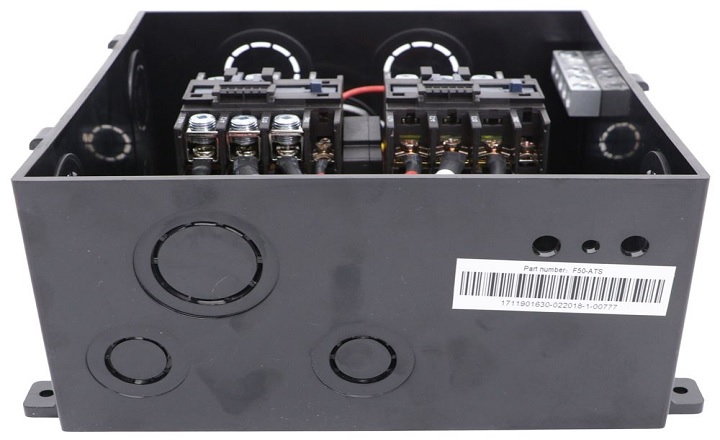How does an RV Automatic Transfer switch work? In this article we have discussed this question. An RV automatic transfer switch (ATS) is a device that allows an RV owner to easily change from park to drive or from drive to the park. It is especially useful when travelling in remote areas where there are no stops available. The ATS can also be used while stopped at a stoplight, traffic jam, or in other situations where changing the park would be dangerous.
RV automatic transfer switches are a type of switch that allows you to transfer power between two RV batteries without having to manually turn them off and on. It allows you to power your RV while parked, even if one battery is low while the other is high.
How Does an RV Automatic Transfer Switch Work?
RVs are one of the most popular vacation vehicles on the market today. There are many different types of them, each with unique features. One of the unique features of an RV Automatic Transfer Switch is that it can automatically switch between two different types of power supply.
RV automatic transfer switch (ATS) is used in RVs to connect two sets of holiday campers. They are often found on the side of a road, and when one group of campers moves to the next set, the ATS automatically transfers them to the new spot. An RV Automatic Transfer Switch (ATS) is an automated system that allows you to transfer fuel or passengers from one vehicle to another without manually switching vehicles. The ATS uses a communication link between the vehicles to determine which should be moved and then automatically transfers the load.
Startup and Switching Time.
Starting an RV automatic transfer system is one of the most important steps when starting your camping or travel trailer. A successful transfer will allow you to move your belongings quickly and easily without worrying about losing anything.
RV automatic transfer works by using a computer to transfer items from one container to another. It is often used in the early stages of a startup or when you want to switch between different containers.
The ATS System.
The ATS system allows you to transfer your caravan or camper from one spot to another without carrying all the supplies and tools. You can also use the ATS system to move your caravan or camper between two campsites.

Why do I Need a Transfer Switch?
Shut down an entire electrical system in your home or office if one or more wires get crossed. A transfer switch is a device that allows you to container and needs to be carried in two. Transfer switches are essential in any household because they can quickly and easily disconnect power to individual devices if something goes wrong.
A transfer switch is an important piece of equipment in a home laboratory. By controlling the flow of chemicals and nutrients through the switches, scientists can control the lab’s environment and work with more precision and control than ever before. With so many different laboratories using transfer switches, it is important to understand why they are so important.
How Does an RV Get Power to Run its Electric Appliances?
An RV needs the power to run its electric appliances, but there are a few ways to get that power. A few things an RV may need include an outlet, a Generator, and an inverter. An RV typically has an onboard generator that provides power to the RV’s electric appliances. It can be a significantly helpful tool if you’re stranded on the side of the road and need to charge your electronics or run your heater or stove.

An RV needs the power to run its electric appliances. The most common way an RV gets the power to run its electric appliances is through a generator. A generator is a machine that can be used to create electricity. Generator sets come in many different shapes and sizes.
Types of Generators
A Battery-Operated Generator
A battery-operated generator set is a type of generator that operates on batteries instead of traditional fuels like gasoline or diesel. These generators are popular for their convenience and portability, making them ideal for outdoor activities, camping trips, and emergencies. They come in various sizes and capacities to suit different needs.
- The primary advantage of a battery-operated generator set is its clean energy source.
- Unlike gasoline or diesel-powered generators that emit harmful fumes, these generators produce zero emissions.
- Battery-operated generator sets require minimal maintenance compared to traditional generators since they do not have an engine that requires regular oil changes or tune-ups. It makes them eco-friendly and safe indoors without fearing carbon monoxide poisoning.
- Another benefit is their noiseless operation; they do not produce disruptive noise like traditional generators and are perfect for use in quiet surroundings.
Diesel Engine-Powered Generators
Diesel engine-powered generators are a popular type of generator used for providing backup power in various settings. They are commonly used in construction, mining, and agriculture industries where electricity is only sometimes readily available. Diesel generators use a diesel engine to convert mechanical energy into electrical energy, which is then supplied to the electrical load.
- One reason why diesel engine-powered generators are so popular is their efficiency.
- Diesel engines have a high compression ratio, making them more efficient at converting fuel into energy than gasoline or natural gas engines.
- Diesel fuel has a higher energy density than gasoline, meaning it can produce more power per gallon of fuel consumed.
- Using diesel engine-powered generators is their durability and reliability.
- Diesel engines have robust components that can withstand tough operating conditions over long periods without breaking down easily.
What is a Typical RV Automatic Transfer Switch Schematic?
A typical RV automatic transfer switch schematic follows the following pattern:

- A master switch (usually a relay) controls the power to all the connected auto vehicles.
- Connection blocks (typically resistors and capacitors) are placed in series between the master switch and each vehicle’s auto-transfer power cord. The series connection limits the current that can flow through each cord, preventing unauthorized vehicles from turning on or off unintentionally.
- When an auto-transfer power cord is plugged into a specific RV, a slave/slave connector is connected to it and serves as an “auto-transfer source” for other RVs in the park. If one of those other RVs is not in use, it remains disconnected from the park’s power grid and doesn’t get power from either of its masters.
- An RV automatic transfer switch schematic is a diagram of the electrical connections between different devices in an RV. The purpose of an RV automatic transfer switch schematic is to help mechanics set up and troubleshoot RV electrical systems.
Conclusion
In the above paragraphs, we have discussed How does an RV Automatic Transfer Switch Work? RV Automatic Transfer Switch is a useful tool for Reveres. They are simple to use and allow quick, easy transfers of people, cargo and vehicles between different sites.
A recent study found that RV automatic transfer switch work can save homeowners up to $1,500 a year in energy costs. The study was conducted by the National Renewable Energy Laboratory and is based on the results of a survey of RV owners.
Frequently Asked Question
What are the Benefits of Using an RV Automatic Transfer Switch?
There are many benefits to using an RV automatic transfer switch. It can help to protect your battery and electrical system from overload. It helps keep your RV running smoothly and efficiently by transferring power from one battery to another when needed. RV automatic transfer switch can save you time and money by automatically transferring power when you connect to a campground or park your RV.
What Are Some Potential Problems with Using an RV Automatic Transfer Switch?
There are a few potential problems with using an RV Automatic Transfer Switch. If the switch is not properly installed or maintained, it may cause electrical issues with the RV. The switch may not handle the power load that an RV can generate, resulting in its failure. If there is a problem with the RV’s electrical system, the switch may not be able to isolate the issue and may cause damage to other components in the RV.

